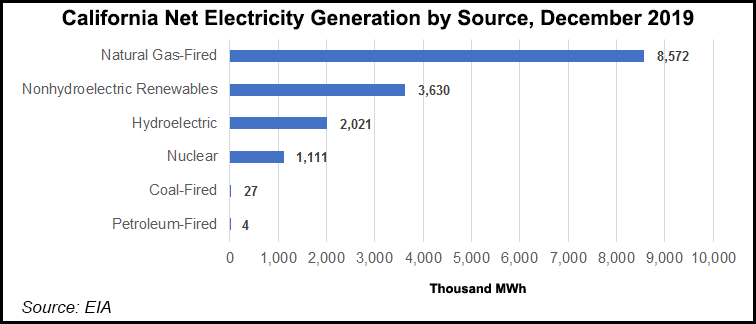Regulatory | NGI All News Access | NGI The Weekly Gas Market Report
California Natural Gas Utilities Supporting State’s Decarbonization
With support from the natural gas distribution utilities, California regulators on Thursday approved major efforts to decarbonize with unprecedented additions of renewables and battery storage, along with pilot electrification programs for new buildings.

The action by the California Public Utilities Commission (CPUC) implements state Senate Bill (SB) 1477, which provides $200 million of cap-and-trade funds over four years for an all-electric buildings program (40%) and a technology program (60%) in which various zero-emission technologies can be used for water and space heating.
The California Energy Commission would oversee the all-electric program and the technology initiatives would be administered by a still-to-be-named third-party overseen by the CPUC. Cap-and-trade allocations from the state’s four major gas utilities would support the pilot tests, with Sempra Energy’s Southern California Gas Co. (SoCalGas) providing nearly half of the funding.
“We’re supportive of California’s decarbonization goals, and we believe SoCalGas has a vital role to play in the new energy future that is underway,” said SoCalGas CFO Mia DeMontigny earlier in March. “This is a future that considers all forms of energy, affordability and customer choice as critical components.”
DeMontigny said natural gas makes up 25% of California’s greenhouse gas (GHG) emissions, while the transportation sector contributes 40%. Another 9% of the GHG volumes come from buildings*. The CPUC’s latest actions on electric planning targets are aimed at buildings, which have been the focus of bans against gas in new construction.
Regulators adopted “a new reference portfolio of resources” for the electric sector to double its amount of clean energy capacity by 2030, calling for nearly 25,000 MW of additional renewable-based power, including 8,900 MW of battery storage, which the CPUC said is eight times the current national U.S. battery storage capacity.
“The reference portfolio achieves an electric GHG emissions reduction of 46 million metric tons (mmt) by 2030, which is 56% below 1990 levels and greater than the current state goal of going 40% below the target levels, said CPUC spokesperson Terrie Prosper.
CPUC Commissioner Liane Randolph said the action permits all the electric utilities and load-serving entities to double the amounts of renewable energy and battery storage under contract.
PG&E spokesperson Ari Vanrenen said the utility supports the latest CPUC action, but he added the caveat that the energy transformation has to be be low- or zero-carbon, as well as reliable and affordable for customers. “We’re focused on a range of solutions that will achieve these goals and be consistent with Commissioner Randolph’s comments,” Vanrenen told NGI.
Meanwhile, during the Sempra briefing earlier this month CEO Jeff Martin was asked about the ability of the company, which has operations outside California, including liquefied natural gas (LNG) export projects in Mexico and Louisiana, to withstand the coronavirus and potential economic recession.
“We’re all in a period of uncertainty, but I am still very confident in our prospects,” Martin said. “Under federal guidelines, the work we do, whether in Louisiana on our LNG project or in California, is infrastructure and therefore categorized as ”essential.’ In most cases you are talking about utility workers, and they understand the challenges in front us. On any occasion they want to run to gunfire, and that is not true of a lot of other industries who are trapped now. We actually have a special responsibility with a destination.”
Whether wildfires or climate change, “we are chartered to help take the risk out of the environment for people,” Martin said.
*The original article misstated the percentage of statewide GHG emissions coming from buildings. NGI regrets the error.
© 2024 Natural Gas Intelligence. All rights reserved.
ISSN © 1532-1231 | ISSN © 2577-9877 | ISSN © 1532-1266 |
